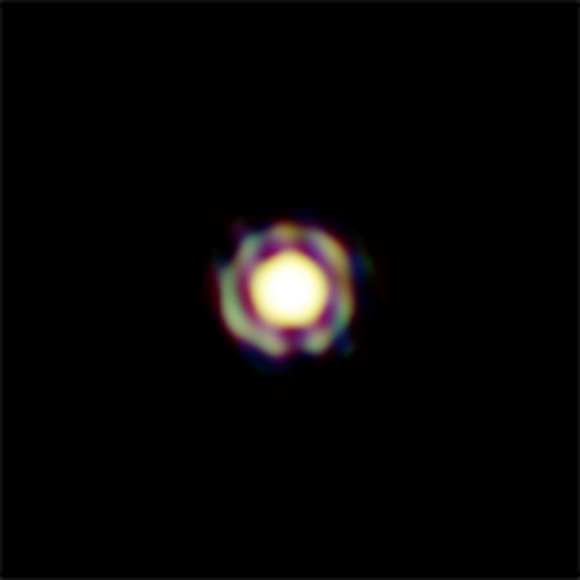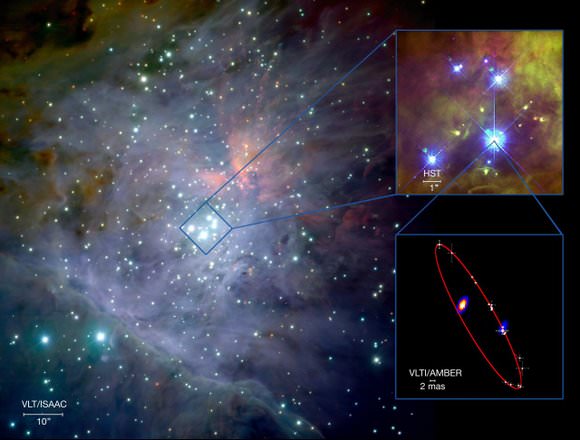- The first VLTI image shows the double star Theta1 Orionis C in the Orion Nebula Trapezium. Credit: ESO
European astronomers are celebrating two of the first images ever made using near-infrared interferometry, and say they herald the dawn of a new era of stellar imaging.
A German-led team has captured images of the double star system Theta1 Orionis C with ESO’s Very Large Telescope Interferometer, which emulates a virtual telescope about 100 meters (328 feet) across. That discovery could lead to a calculation of the orbits and mass of the system. And a team of French astronomers has captured an image of the star T Leporis revealing a spherical molecular shell around the aged star — which appears, on the sky, as small as a two-story house on the Moon. Both feats were announced today by the European Organisation for Astronomical Research in the Southern Hemisphere (ESO).
“We were able to construct an amazing image, and reveal the onion-like structure of the atmosphere of a giant star at a late stage of its life for the first time,” said the ESO’s Antoine Mérand, a member of the T Leporis research team. “Numerical models and indirect data have allowed us to imagine the appearance of the star before, but it is quite astounding that we can now see it, and in colour.”

Interferometry is a technique that combines the light from several telescopes, resulting in a vision as sharp as that of a giant telescope with a diameter equal to the largest separation between the telescopes used. Achieving this requires the VLTI system components to be positioned to extraordinary accuracy over the 100 meters (328 feet) and maintained throughout the observations — a formidable technical challenge.
When doing interferometry, astronomers must often content themselves with fringes, the characteristic pattern of dark and bright lines produced when two beams of light combine, from which they can model the physical properties of the object studied. But, if an object is observed on several runs with different combinations and configurations of telescopes, it is possible to put these results together to reconstruct an image of the object. This is what has now been done with ESO’s VLTI, using the 1.8-meter (6 foot) auxiliary telescopes.
The new T Leporis results are set to appear in a letter to the editor in Astronomy and Astrophysics, by lead author Jean-Baptiste Le Bouquin, also of the ESO, and his colleagues. The image of Theta1 Orionis C, in the Orion Nebula Trapezium, is reported in an Astronomy and Astrophysics article led by Stefan Kraus at the Max-Planck-Institut für Radioastronomie in Germany.
Although it is only 15 by 15 pixels across, the reconstructed image of T Leporis shows an extreme close-up of a star 100 times larger than the Sun, a diameter corresponding roughly to the distance between the Earth and the Sun. This star is, in turn, surrounded by a sphere of molecular gas, which is about three times as large.
T Leporis, in the constellation of Lepus (the Hare), is located 500 light-years from Earth. It belongs to the family of Mira stars, well known to amateur astronomers. These are giant variable stars that have almost extinguished their nuclear fuel and are losing mass. They are nearing the end of their lives as stars, and will soon die, becoming white dwarfs. The Sun will become a Mira star in a few billion years, engulfing the Earth in the dust and gas expelled in its final throes.
Mira stars are among the biggest factories of molecules and dust in the Universe, and T Leporis is no exception. It pulsates with a period of 380 days and loses the equivalent of the Earth’s mass every year. Since the molecules and dust are formed in the layers of atmosphere surrounding the central star, astronomers would like to be able to see these layers. But this is no easy task, given that the stars themselves are so far away — despite their huge intrinsic size, their apparent radius on the sky can be just half a millionth that of the Sun.
“Obtaining images like these was one of the main motivations for building the Very Large Telescope Interferometer,” Mérand said. “We have now truly entered the era of stellar imaging.”
Source: ESO


truly an awesome achievement! go science!
Congrats to all involved in ESO’s VLTI program. These difficult and demanding observations should inspire other astronomers & engineers at observatories around the world now building similar optical interferometers. Truly a new era for optical astronomy!
Awesome!!!!
One day, when we finally have a permanent base on the moon, that would be the perfect place to put a large optical telescope…..when using the techniques mentioned in TFA, one can imagine the benefits of having a separation between telescopes of Earth-Moon distance…
This is exciting stuff!! Science is so cool sometimes….
That is simply outstanding. I’ll be looking at the trapezium with renewed interest this weekend!
By the way, has someone ever used _one_ telescope to observe the same object at a certain time _and_ half a year later? This would be emulating a telescope about 300 million km across (the diameter of earth’s orbit around the sun). This could be appropriate to observe phenomena, which don’t change much over time. May be, you can do this with a small, but technically sophisticated back yard telescope too.
Alex Jones: If I understand interferometry correctly, your idea won’t work. One must observe the _same_ light from both observation points at the same time to record the interference… like the famous “double slit experiment”. which also records an interference of sorts.
If Alex Jones’ idea doesnt work, then how about putting a telescope up exactly opposite earth from the sun and use 2 clone telescopes to view. That would work wouldnt it?
It would have to be exactly opposite.
@Alex,Feenixx,Zibit: Phase interferometry requires, as is mentioned in the post above, that the telescopes and all the involved optics be kept at distances exact down to a fraction of the wavelength of the light.
Because of this, one usually carries out interferometry in the infrared (long wavelengths), but even here you need to control your telescopes’ distances down to a micrometer or so – a tremendously challenging task.
Since the technique relies on interference from the light at different telescopes you need the observations to be simultaneous.
There have been plans for a space based interferometer with a hundred or so telescopes flying in a formation a few kilometres wide, but this would be extremely expensive and is unlikely to happen anytime soon, if ever.
Feenixx: “If I understand interferometry correctly, your idea won’t work. One must observe the _same_ light from both observation points at the same time to record the interference …”
H: “… all the involved optics be kept at distances exact down to a fraction of the wavelength of the light.”
I see. That’s … difficult.
I have never read something about any device – analog, may be: holographic – to record the light from one interference path and replay it later, when the light from the second path comes in, in order to get some useful interference pattern. Does anybody know something about this?
Naah, why go to all that trouble? Just flick a couple of nextstar 6’s in orbit around the sun with mobile phone GPS units duct-taped to them. Hack a couple of robosapiens to control them.
I mean, how hard can it be?! I bet the mythbusters could do it 😀
“Ground control to Major Tom… Robosapien one, adjust tracking to 32 Eridanius and boost separation another AU. Out.”
If it doesn’t work like in the movies just use more C4.
Recording light with phase information intact is simply not possible with today’s technology I think. Besides, you would still need to record it at the exact same time.
I do, however, recall something about an interferometry experiment where radio waves where recorded at a site in Europe and a site in the US simultaneously and then combined off-line at a later time. With radio waves, things are a bit simpler because of the much longer wavelenghts.
Doing optical backyard interferometry is unfortunately completely unrealistic. This is one of the most technically challenging and expensive techniques in all of astronomy.
By the way, here’s the article about Luciola, the envisioned flying space interferometer: http://adsabs.harvard.edu/abs/2008ExA…tmp…48L
H: “Doing optical backyard interferometry is unfortunately completely unrealistic.”
That’s too bad.
Back at university, about 35 years ago, I made an experiment measuring the speed of light. This involved interference of two light beams originating from the same laser source. I had much fun – and I have it still today remembering – because the average of _three_ measurements was accurate in the _four_ most significant digits 😉
I would be great, if soon hobbyists will be able to do optical interferometric astronomy cheap and easy. For me it’s especially important, because my eyes are not good enough to do “normal” optical astronomy, and I would have to evaluate the incoming light by computer software anyway. That’s one reason, why I appreciate the internet and Universe Today so much, by the way.
So what – I want backyard x-ray and gamma-ray astronomy! 😉